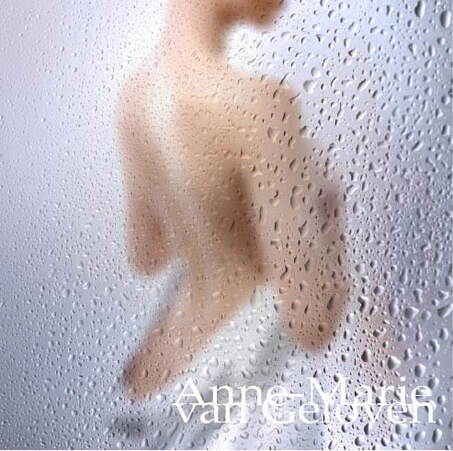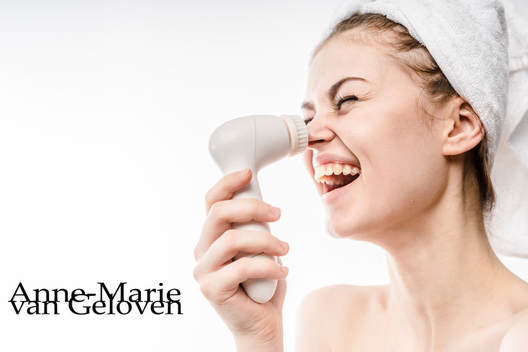
Skin complaints related to visual display terminals (VDTs) such as smartphones, tablets, and computers are on the rise. Visually it's a rosacea-like dermatitis (erythema, oedema, papules or pustules), and can be accompanied by itch, pain and smarting (1). Some only have subjective symptoms and no visible skin problems.
It was thought that this skin condition might be caused by prolonged and repeated exposure to blue light emitted by electronic devices. The term "blue light" refers to the high-energy visible (HEV) light spectrum, which is present in the blue region of the visible light spectrum. As we are spending more and more time with or in front of screens from computers, tablets, or smartphones, there are increasing concerns about the harmful impact of blue light on skin. When referring to these light sources, we talk about artificial blue light. Dr Ludger Kolbe (Chief Scientist Photobiology) tested the radiation onto the skin emitted by different smartphones and tablets from various distances. Findings: the amount of blue light emitted during the conventional use of electronic devices is by far not enough to trigger harmful skin effects. If you sit in front of a monitor uninterrupted for a week at a distance from the screen of approximately 30 cm, this would be the same as the blue light intensity of spending one minute outside on a sunny day in Hamburg Germany at around midday at midsummer. If you hold a smartphone right next to the skin, the intensity does increase, but it would still take approximately 10 hours of uninterrupted use to match the effect on the skin of just one minute of sunlight as described. The emissions from electronic devices are barely noticeable in comparison to natural blue light directly from the sun and are, thus, negligible. The same does not apply for natural HEVIS, which does harm the skin. So is HEVIS from a screen is not causes screen dermatitis, what does? Overall, there is an overlap with skin complaints in buildings with ‘climate control’ problems (2), which may explain why screen dermatitis is relatively more common in atopic patients. The same authors found psychosocial conditions and high work-related stress to be indicators for developing VDT-related facial skin problems. Berg et al. (3) found that these patients frequently have sensitive skin: they are so-called ‘stingers’, reacting with stinging or itching when lactic acid (5%) (LAST-test or Lactic Acid Sting Test). In a large literature study, screen dermatitis was found to show many similarities with skin damaged by UV light or ionizing radiation (4). Ionizing radiation consisting of particles, rays with sufficient energy to cause ionization in the medium through which it passes. Examples are heat or light from the sun, microwaves from an oven, X rays from an X-ray tube and gamma rays from radioactive elements. In this large literature study, not only clinical but also immuno-histological manifestations were evaluated. Most striking was the increased number of mast cells in screen dermatitis, containing histamine. The latter is known to be released when mast cells are exposed to UV light and may be responsible for symptoms of itch, pain, oedema and erythema in screen dermatitis. Furthermore, Langerhans' cells in the epidermis were significantly decreased or virtually absent in screen dermatitis as well as in skin damaged by UV light or ionizing radiation. On the other hand, levels of some neuropeptides were determined, and although several differences were found with normal skin, no single marker was 100% able to distinguish between healthy skin and screen dermatitis (1). It is unclear whether VDTs leak electric or magnetic fields that affect our cells (4). In keeping with these findings are the conclusions of a case-referent study, stating that screen dermatitis most likely is the result of non-specific or irritant factors in subjects with sensitive skin (2). In conclusion: It is highly recommended to use SPF and protect the skin from natural HEVIS (with for example product containing Licochalcone A). However protection against artificial blue light won't likely prevent or improve screen dermatitis symptoms. Always consult your dermatologist for a proper diagnose and treatment. Take care. References:
Comments

Reading the instructions on cleansing and care products can be misleading. When do I pat my skin dry first or when do I apply the product on damp skin? Even many recommendations from skin care guru's or skinfluencers are not completely correct.
In general it is recommended to apply a serum, eye care or moisturising / hydrating care product on damp skin, or immediately after bathing for the following reasons: Increased Absorption The primary benefit of applying skin care products to damp skin is that the skin is more receptive to the ingredients. Water helps to increase the hydration levels of the skin cells, which then improves the absorption of the skincare products. When the skin is damp, the skin's surface is more permeable, allowing the ingredients in the skin care products to penetrate deeper into the skin, and work their magic. Absorbing the ingredients more effectively, this leads to better results. The exception are products which require a very low pH level to penetrate, and be more effective, for example L-Ascorbic Acid (Vitamin C) and chemical exfoliating "acids" like hydroxy acids. The reason is that water has a pH level of 7-8, acidic formulations will be "neutralised" on damp skin. Better hydration Applying skin care products to damp skin helps to lock in moisture, leaving your skin feeling soft, supple, and hydrated. Hydration is critical for the skin because it helps to maintain and restore the skin's barrier function. The skin barrier protects the skin from losing hydration and prevents irritants and bacteria from entering. Applying serums and moisturisers on damp skin, increases the hydration benefits from the products. Improved spreadability Another advantage of applying skincare on damp skin is that it helps to improve the spreadability of the product. When we apply products such as serum or moisturiser to dry skin, they tend to settle in one area and can be challenging to spread evenly. On the other hand, when applied to damp skin, the skin care products can spread easily and evenly across the skin surface, ensuring maximum coverage and benefit. The exception are lipid rich products which are hydrophobe (water repelling), for example ointments, they might not spread evenly or easy on damp skin. Enhanced performance Applying skin care products to damp skin has been shown to improve their performance. This is because when products are applied to damp skin, they are less likely to evaporate, and the ingredients remain active for longer. This increased contact time with the skin leads to better, more effective results. The exception are products containing vitamin A, retinoids, tretinoin, retinal, retinol, retinaldehyde as damp skin increases the risk of irritation. Sensitive and hyper-sensitive skin Usually people with sensitive and hyper-sensitive skin have an impaired skin barrier function, hence ingredients will penetrate better in comparison to a resilient and well-functioning skin barrier. Applying products on (hyper)sensitive skin will therefore increase the risk of irritations. Be mindful which ingredients you use and use a pH rebalancing toner after cleansing and prior to any serum or care product you use. A toner is anyway an affordable product, which I highly recommend to use in every skin care routine. Read more. Study results on patients with dry skin and healthy volunteers In healthy subjects, compared to at control sites, the Stratum Corneum Water Content (SCW) was significantly higher at sites treated with the moisturizer immediately after bathing, with 1.0 and 2.0 mg/cm2 of the moisturizer, and with once- and twice-daily applications. In patients with dry skin, the SCW was significantly higher compared to control sites after 8 weeks when the moisturizer was applied twice daily. Read more. Take care. 4/30/2023 Comments All you need to know about baby skin
Baby skin is different from adult skin: more sensitive and less resilient. It is important to understand the differences, as it influences how to care for baby skin.
At birth, baby skin undergoes a dramatic change from an aqueous (in the womb) to a dry environment. Baby skin, hair, and fingernails all start to form during the first trimester of pregnancy and continue to develop.
RECOMMENDATIONS FOR BABY SKIN CARE 1. Avoid Fragrance and Other Irritants Fragrances and other irritants can exacerbate skin conditions in babies, such as eczema. Avoid products that contain fragrances, sulfates, and other ingredients that may cause irritation. 2. Use Gentle Cleansers When bathing your baby, use mild, soap-free cleansers that are specifically formulated for baby skin. Avoid using harsh soaps or chemicals that can strip the skin of natural oils. 3. Avoid Over-Bathing While it may be tempting to give your baby frequent baths, it is important to avoid over-bathing. Bathing too frequently can dry out the skin and cause irritation. Aim to bathe your baby no more than every other day, or as recommended by your pediatrician. 4. Moisturise Regularly To help maintain the skin’s natural moisture barrier, apply a gentle, fragrance-free moisturizer to your baby’s skin after bathing. Look for products that are specifically formulated for baby skin, and avoid those that contain ingredients that may cause irritation. 5. Be Sun-Safe Frequent sunburns and exposure to sunlight in childhood are strongly related to melanoma development; therefore, appropriate measures of photoprotection have been considered to decrease the risk of melanoma and nonmelanoma skin cancer. Since baby skin is more susceptible to damage from UV radiation, it is important to protect your baby from the sun. Use a broad-spectrum sunscreen, that is specifically formulated for babies, compliment this with a hat and special UV protective clothes if needed and avoid exposing your baby to direct sunlight during peak hours. 6. Prevent Diaper Rash Protect babies bum 24/7 from a nasty diaper rash. A safe and affordable product known to prevent, soothes and treats diaper rash is Aquaphor, There are special baby formulations available which can also include ingredients like zinc oxide and pathenol and off course are fragrance fee. In case of doubts or concerns don't hesitate to consult your pediatrician or pediatric dermatologist. Take care. 2/23/2023 Comments Cosmetic Intolerance Syndrome
Dermatologists and pharmacy-assistants or pharmacists are regularly confronted with consumers or patients who have tired about a 100 skin care products and "react" to almost all of them. This could be seen as sensitive or hyper-sensitive skin: self-reported facial presence of different sensory perceptions including tingling, stinging, burning, tingling, pain and pruritis (itch). Sensitive skin was first described by Maibach in 1987 under the name of Cosmetic Intolerance Syndrome. Irritant contact dermatitis (ICD) is caused by the non–immune-modulated irritation of the skin by a substance, leading to skin changes. Allergic contact dermatitis (ACD) is a delayed reaction in which a foreign substance comes into contact with the skin; skin changes occur after re-exposure to the substance. Sounds dramatic, and it is. Buying products to find out that you can not use them is a waste of money, disappointing and if you don't know the cause it is utterly frustrating or problematic. Symptoms can appear local systemic, occur immediately or sometimes with a delay of several hours or days and range from mild to very severe in case of a serious allergic reaction (even life threatening anaphylaxis) and may impact quality of life and/or sleep.
An easy way to avoid wasting your money on a new product is to ask for a sample. It is the most important reason why they exist. Usually with a few applications you can tell if you like the product and your skin likes it too. To find out specifically why your skin is (hyper-)reactive it is smart to go to your dermatologist and ask him/her/they for a test and advice after doing some home-work. You can prior to the appointment make a report as detailed as possible. Checklist for the appointment for a dermatologist / allergologist should contain: symptoms with timing, affected areas (face, scalp, body), co-medication, (family) history of skin diseases (for example atopic dermatitis, psoriasis, rosacea), occupational hazards (for example hair dressers exposed to chemicals), dietary changes, stress, menstrual cycle, use of washing detergents / fabric softeners, sun exposure (photosensitivity) or environmental triggers or changes (like mega-city pollution or skiing by low temperatures or wind), wear of (tight) clothes and anything you deem relevant like recently undergone (aesthetic) treatments. Of course cross-check the INCI's or ingredient lists of the products you use if there are common ingredient(s) listed. Most common triggers in cosmetics are easy to find: latex, dyes, metals and fragrance. Some ingredients are beneficial for skin, but your skin may need slowly adjust to them, like tretinoid or retinol. Some ingredients may be beneficial for some, however not good for your skin when used on a daily base like alpha-hydroxy-acids in high concentrations. I know that many mention preservatives as a potential trigger. Some certainly can be. However my experience (about 9 years of clinical tolerability and safety tests with modern dermatological skin care) is that almost all users tolerate products containing evidence based modern preservatives really well (rarely any side effects) and benefit from them as they reduce the risk of contaminations by unwanted growth of microflora in a product. Hence, they are there for your safety. Large companies have thousands of people working in R&D every day and know what they are doing and are there to provide you with the best they can offer, based on the latest regulations, insights and science. Moreover, they would not market products risking high complaint rates or more dermatological skin care without clinical proof of good / very good tolerability (even in sensitive skin). I therefor like to challenge the negative reputation preservatives in general have. We all remember that parabens were "killed" by reputation and because companies want to produce products consumers enjoy and love, they started formulating all their products without them. Truth is that most parabens were and are very safe based on ample evidence. In this case a family of beneficial preservatives suffered significantly because of 1 or 2 bad family-members. We don't formulate with parabens or known potential allergens. A very active and skilled safety department is taking care of that. Don't completely rely on the word hypo-allergenic. It only means that the risk of a reaction to one of the ingredients is reduced and does not provide a 100% guarantee. Don't think that "everything natural" is always good for you. For example latex (a well known potential allergen) comes from nature. Click the button below for a full list of potential allergens in skin care provided by the FDA. There are preservative, fragrance and dye free options available in skin care. Although "free off" claims are frowned upon by the industry or sometimes not even legal. Usually these "minimal" products come in specific safe packaging (mostly pumps) to avoid contamination, often also protecting them from air and light to avoid oxidation of certain ingredients in the formula. There are evidence based dermo-cosmetic products which actively sooth and calm the skin with ingredients like Symsitive®, reduce related redness or inflammation with licochalcone A or cool or reduce itch with methoxy-propanediol or polidocanol or a combination. Sometimes the solution is as simple as the problem. Sensitive (hyper) reactive skin can be caused by barrier impairment, which allows irritants to penetrate the skin, sensors in the skin to be exposed and water to evaporate from the skin.....hence often confused or overlapping with dry skin as the symptoms are identical. If your skin barrier is the problem, the solution is to avoid over-exfoliation or harsh cleansing, maintain the skin's healthy pH (around 5) and use products containing ingredients supporting barrier repair like urea and/or dexpanthenol. These are considered the gold standard as written in this position paper by Prof. M. Augustin et al 2019. In my opinion all skin is "sensitive", and it should be. It is our skin's function to protect us by sensing heat, cold, touch, pressure and pain for example. However when the skin does not tolerate "normal conditions", hence is overreacting to (common) ingredients in skin care, it is telling you "something is off" and it might be Cosmetic Intolerance Syndrome. Listen to your skin. Don't forget to ask for a sample and advice from the pharmacist when buying a new product or go to your dermatologist/allergologist to get a better understanding of the problem, so they can provide a tailored solution for you. Take care 
We all learned that sleeping in make-up is the ultimate skincare sin. What is bad about it is when you go 24 hours without washing your face and end up going to bed leaving your day-time make-up on. Over the course of the day, our skin accumulates pollutants, dirt and dead skin-cells.
If dirt and pollutants are left on the skin, they may cause micro-inflammation and contribute to premature ageing skin via a process called inflamm-aging and free-radical damage which is a major contributor to skin-ageing. The combination of both micro-inflammation and free-radical damage is called ox-inflammation. We should aim to reduce or preferably avoid it. Pollution, dirt and sebum (oils) can impact the skin's healthy pH balance and thus lead to a weakening of the skin barrier function, more sensitive skin, dehydration, slowed down skin-cell renewal process and thus ageing. Not removing dead skin cells together with dirt increases the risk of clogged pores. Make-up itself usually doesn’t contain harming ingredients. Coloured micro-pigments actually provide additional sun-protection. Make-up or foundation itself is thus not the problem, however the fact that we don’t cleanse our skin after a busy day and/or evening is what could make us age faster. Not doing your PM cleanse and care routine is anyway a missed opportunity to support your skin’s night-time recovery with beneficial active ingredients. If you go out in the evening, take the opportunity to cleanse before getting ready and get rid of debris which was accumulated during day-time. Don’t worry about falling asleep in your make-up once or twice. Just don’t make it a habit. I would always aim to remove eye make-up. Sleeping in full eye make-up (mascara, liner, eyeshadow) increases the risk of an eye-inflammation, redness and corneal abrasions. Waking up with “panda-eyes” filled with black rheum or goop isn’t pretty either. Take care 
One of the frequently asked questions is, if it's necessary or if there is a benefit using a special eye care or cleansing products. Yes, there is!
As I mention in many of my previous posts, the right pH-level is very important for healthy skin. Skin usually prefers a pH of around 5. However there are some area's where the skin's natural pH balance is a little bit different. One of those area's is the area around the eyes. The preferred pH-level there is around 7, thus less acidic and more alkalic in comparison to your regular cleansing or care product for face or body. This is one of the most important reasons why I would recommend to use a special eye make-up remover and eye care product, as they are adjusted to the pH level most suitable for use in the eye area. Furthermore, special eye products are tested and proven to be safe when used around the eyes, while it isn't always recommended or proven for a regular face product. Some care products have a tendency to "travel" or migrate into the eye area. Even when not directly applied around the eyes, they might end up there. A special eye care product can form a "barrier" and thus help to prevent that unwanted products move to the eye area and cause irritation. I would particularly recommend the use of an eye cream when using other products containing gold standard anti-ageing active ingredients like Vitamin A, C (or derivatives of both), Hydroxy Acids (Alpha, Beta or Poly), when you have experienced some sensitivity of the eyes or eye area in the past or have a more problematic skin type. Eye care products preferably should not contain Vitamin C (L-Asorbic Acid or related) as it requires a low pH value of <4 to be active and do it's job properly. Eye care products with Vitamin C therewith are either too acidic to be used in the eye area or alternatively too alkalic for the Vitamin C to be effective. Safe to use in the eye area are products containing Hyaluronic Acid. Although "Acid" is in the name, Hyaluronic Acid isn't acidic. One of it's key functions is attract and bind water, which usually has a pH of ~7. Take care! 7/22/2018 Comments Chemical or mechanical exfoliation
We can support's skin natural exfoliation process in various ways, for example with mechanical or chemical exfoliation.
Desquamation (shedding of skin cells thus exfoliation) is an important part of the skin's natural regeneration or renewal process. Already in our twenties, this process slightly, however increasingly starts to slow down (Kligman 1983). As a result, the cells on the surface of our skin (corneocytes) become bigger (Kligman 1989) and a little disorganised. This leads to a duller appearance (loss of radiance) and a more rough texture of our skin. A very comprehensive comparison of both methods:
The word "acid" unfortunately sounds very harsh and skin-unfriendly. Many acids are actually skin's own, like for example lactic acid is a skin's own natural moisturising factor (NMF) and so is hyaluronic acid. The level of NMF's decrease as we age and our skin my lose the ability to maintain well hydrated. Many years ago the benefits of lactic acid were capitalised by using baths filled with donkey milk. Citric acid is commonly used in skin care products and toners to balance skin's pH. Gluconolactone is only gradually penetrates skin and is very gentle.
It's unfortunate that "acids" have such a negative connotation, as our skin (healthy and problematic) can benefit if we use them regularly. Moreover, I prefer this method over mechanical exfoliation for all skin types, however particularly if you have dry skin, acne- or redness prone skin, sensitive skin or mature skin. The risk of exfoliation is over-exfoliation. Over-exfoliation is damage of our skin barrier and the symptoms are very comparable to dry or (hyper) sensitive skin symptoms, which are: redness, irritation, tightness, excessive dryness, dry patches, flaking skin, uncomfortable stinging, or even burning sensation. Whenever you experience one or more symptoms of over-exfoliation, it's recommended to reduce the number of times you exfoliate and support the skin barrier repair with a moisturiser. Hope you enjoy healthy skin & take care. |
CategoriesAll Acne Ageing Aquatic Wrinkles Armpits Biostimulators Blue Light & HEVIS Cleansing CoQ10 Cosmetic Intolerance Syndrome Deodorant Dermaplaning Diabetes Dry Skin Evidence Based Skin Care Exfoliation Exosomes Eyes Face Or Feet? Facial Oils Fibroblast Fingertip Units Gendered Ageism Glycation Gua Sha Hair Removal Healthy Skin Heat Shock Proteins Hormesis Humidity Hyaluron Hyaluronidase Hypo-allergenic Indulging Jade Roller Licochalcone A Luxury Skin Care Lymphatic Vessel Ageing Malar Oedema Menopause Mitochondrial Dysfunction Mood Boosting Skin Care Neurocosmetics Ox Inflammageing PH Balance Skin Photo Biomodulation Polynucleotides Psoriasis Regenerative Treatments Review Safety Scarring Sensitive Skin Skin Care Regimen Skin Flooding Skin Hydration Skin Senescence Skip-Care Sleep Slugging Sunscreen Tanning Under Eye Bags Vitamin C Well Ageing Skin Care Wound Healing Wrinkles
Archives
April 2024
|



 RSS Feed
RSS Feed
